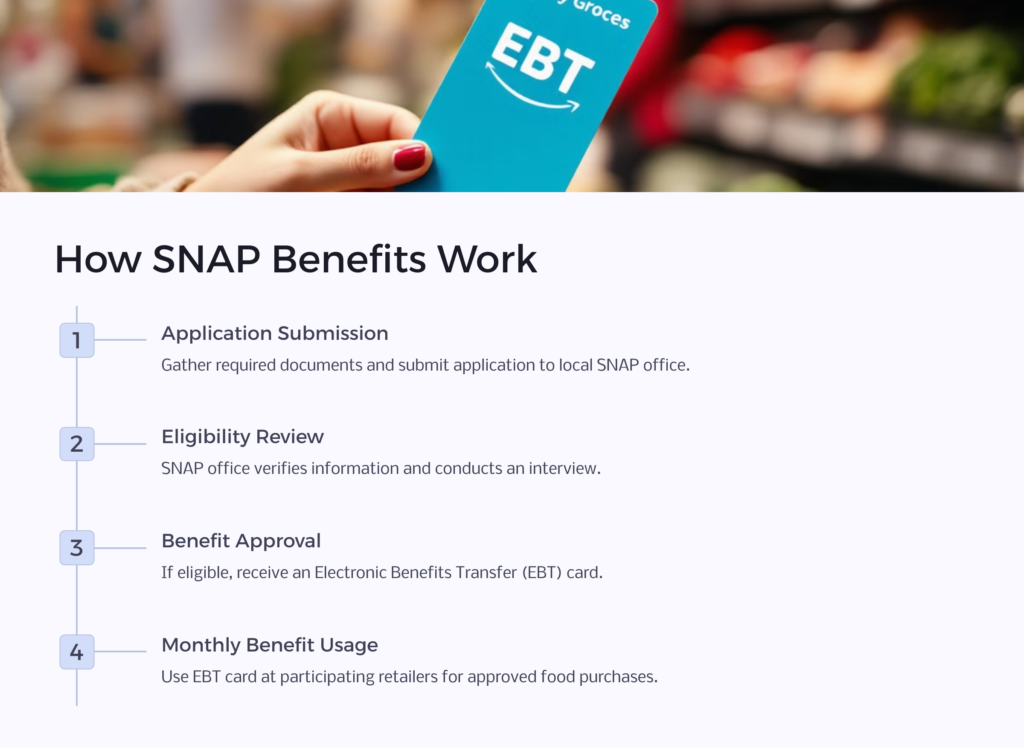You may know the Supplemental Nutrition Assistance Program (SNAP) by its former name: Food Stamps. This vital U.S. government assistance program provides millions of low-income households yearly with cash assistance for healthy food. If you’re in the process of applying for Food Stamps, there are several items you’ll need to gather to verify parts of your application. We’ve outlined them for you here.

5 Ways You May Be Eligible for Food Stamps

- You work part-time or for low wages
- When household members are unemployed (sometimes temporary assistance)
- If your household receives welfare or other public assistance payments
- Your household includes elderly or disabled and classified as low-income
- If you are homeless
Approved SNAP participants receive monthly benefits via an Electronic Benefits Transfer card (EBT card). It works like a debit card and can be used at any participating retailer. These retailers typically include most grocery stores, some convenience stores, and gas stations, along with some big-box stores like Target or Walmart, pharmacies, and even local food stands, food cooperatives, or farmers’ markets.
Generally, household benefits are allocated under the assumption that roughly 30% of a household’s income should be devoted to food purchases. The SNAP benefit is meant to supplement a family’s income, so the expectation is that the eligible household will use some of its own take-home income for food, in addition to the monthly benefit received.
8 Documents Needed to Apply for Food Stamps
- Identification
- Proof of Citizenship
- Proof of Residence
- Earned and Unearned Income
- Medical Expenses
- Household Expenses
- Proof of any Disabilities
- Proof of any School Attendance
SNAP is administered federally by the U.S. Department of Agriculture and the Food and Nutrition Service and administered through local SNAP offices. This Food Stamps program features a rigorous application process. To be approved for food assistance, you need to provide specific information about every member of your household. This information ranges from financial situation and history to job history and other personal information.
To make sure your application is successful, it helps to have access to the documents we’ve outlined here. Submitting the correct documentation with your application will make it easier for a SNAP reviewer to see the merit of your claim. Once approved, you will begin to receive monthly cash assistance loaded onto an Electronic Transfer Benefit or EBT card, which you can use much like a debit card.
How to Apply for SNAP Benefits
Depending on your state’s specific process, there are usually several different ways to apply for SNAP benefits—for example, many states use online portals that allow you to submit your application and supporting documents all in one convenient spot. You can also apply for assistance over the phone or in person at your local SNAP office.
Also, requirements may vary by state, so make sure to check with your local SNAP office to find out what kinds of documentation will be accepted.
1. Identification
One of the most important components of your SNAP application is your identity. You must be able to show documented evidence that you are who you say you are, including documentation of your full legal name and your date of birth. In most cases, this may also mean presenting a photo ID, which can be a driver’s license, voter registration card, U.S. passport, military ID, school ID, etc. In some cases, you may be able to use your birth certificate as proof of identification. You may also be able to submit documentation such as census records, adoption records, or a naturalization certificate.
2. Proof of Citizenship
It’s important to remember that SNAP benefits are designated for the benefit of U.S. citizens. Non-citizens can also apply if they have documented permission to live in the United States. You can include a copy of your birth certificate, citizenship/naturalization documents, green card, employment authorization card, U.S. passport, or military records to show that you fall within one of these categories.
You also may submit a letter or any other documentation from U.S. Citizen and Immigration that specifies your status. U.S. citizens must have a valid Social Security number. You can present your Social Security card or submit a photo I.D. with your birthdate. This allows a SNAP reviewer to look up your Social Security number.
3. Proof of Residence
One of SNAP’s chief requirements for assistance is that you must apply for food benefits within your state of residence. A SNAP reviewer will verify your place of residence. You can submit documentation such as a current lease or a rent receipt if it lists your full legal name and address. You can include a letter from your landlord that verifies your address, a voter registration card, or mortgage records if you own your home. In some cases, SNAP may also accept a letter from a source outside your household verifying your address. You can even submit a copy of your library card if it shows your current address.
4. Earned and Unearned Income
Your income records are one of the most important components of a successful SNAP application. Your local SNAP office will first verify that your household falls within the SNAP guidelines for income and resources. In some cases, your state may also offer an online screening tool that can help you determine that your income meets appropriate SNAP eligibility criteria.
To be approved for Food Stamps, you must show that your household income is at the federal poverty level. The federal government defines this level and represents what a household needs to earn to afford necessities like shelter, food, and basic utilities. The federal poverty level is a consistent standard used to judge eligibility for many different government assistance programs, and it is adjusted each year. The poverty level varies based on household size.
To document your income, you can provide several different kinds of documents: paycheck stubs, tax records, bank statements, or even a letter or formal statement from your employer verifying your income. You must include documentation of any unearned income—for example, benefits award letters from your state or the Social Security Administration, child support award letters, or statements showing payment of dividends, pension payments, and other sources of income.
You also need to disclose any available resources or assets. This may include bank statements, copies of bonds or stock certificates, and deeds to any properties, recreational vehicles, boats, motorhomes—any assets you have that are not used as a primary living space or to earn income.
5. Medical Expenses
If you’re caring for an elderly or disabled household member and carry associated medical expenses, you will need to provide appropriate documentation. This can include copies of medical, dental, or mental health care bills and statements. For SNAP application purposes, these bills can be either paid or unpaid. You can also submit bills or statements for expenses related to prescription drugs, prescription eyeglasses, hearing aids, service animals, prosthetics, or dentures.
If you live in a rural area, you can submit costs associated with medical transportation and lodging. Anyone applying can submit documentation of Medicare and other health insurance premiums. If you have receipts for reimbursed expenses, you should submit those as well.
If someone in your household struggles with major health issues, it may also be worth checking into what other medical assistance they could be eligible for.
6. Household Expenses
Known as a shelter deduction, your household expenses are an important part of your application. These costs factor heavily into determining whether your household falls above or below the federal poverty level. To document your expenses, be prepared to submit mortgage statements, copies of rental receipts, proof of homeowner’s insurance, property tax records, and copies of basic utility bills—like gas, electricity, water, sewer, and telephone bills. You can also submit a letter from your landlord verifying the expenses associated with renting your home. Be sure to include proof of dependent child care expenses, such as child support or dependent child care documents and receipts for dependent child care costs.
7. Proof of any Disabilities
The SNAP program recognizes that the expenses associated with caring for a disabled household member can make it more difficult to purchase food. As part of your application, you can submit any documentation of your eligible household member’s disability, including medical records, documentation of diagnosis, or a letter from your household member’s physician outlining the specific disability.
8. Proof of any School Attendance
Are Students Eligible for Food Stamps?

In some cases, yes, students may be eligible for SNAP benefits. Most able-bodied students aged 18-49 who are enrolled in college courses at least half time are not eligible for benefits.
However, students whose situations meet the following criteria may be eligible for food assistance:
- They work at least 20 hours a week
- They are the primary caretaker for a dependent child under age 6
- They are enrolled in a state or federally-financed work study program
- They currently receive public assistance benefits under a Title IV-A program
- They have primary caretaking responsibilities for a dependent household member between the ages of 5 and 12, and do not have adequate child care to attend school and work a minimum of 20 hours, or to take part in a state or federally financed work-study program
- They participate in one of the following programs:
- A training or employment program under the Food Stamp Act
- A program under Section 236 of the Trade Act of 1974
- A program under the Workforce Investment Act of 1998
- Any other state or federal training or employment program
- They are a single parent and the primary caretaker of a dependent child under age 12 and enrolled in college courses full-time
The Food Stamps Interview

Once you have submitted your application and all supporting documentation, you should hear from your local SNAP office within about 30 days to schedule a SNAP interview. The interview is an important part of the review process. It allows a SNAP reviewer to verify your identity and fill in any information gaps in the written documentation you submitted. You should be able to set up your SNAP interview in person or over the phone.
During your interview, your SNAP reviewer will go through all elements of your application and verify your information. In some cases, you may be asked for additional documentation to support your case. Perhaps most importantly, your SNAP interview is an opportunity for your local SNAP office to verify your information to guard against fraud. This interview also allows your SNAP reviewer to recommend that your application be expedited if your eligible household is in an emergency situation that merits a faster review.
You’ll also find out more specific program information about the amount of monthly benefit you can expect on your EBT card, along with the specific terms associated with your food stamp benefits. The SNAP reviewer isn’t the only one asking the questions during the interview – this is also an opportunity for you to ask any questions you have about the assistance program.
What If My Application is Denied?

If your SNAP application is denied upon first review, don’t lose heart. You still have the option to appeal the decision and request a fair hearing. In the case of a denial, you’ll receive a detailed letter from the SNAP program outlining the reasons why your application was denied. The denial letter also outlines the next steps you should take if you’d like to challenge the decision. Keep in mind that the appeal process may vary from state to state. Depending on your state, you may need to attend an informal hearing or submit additional documentation.
Applying for Food Stamps Assistance
For more than 75 years, the Supplemental Nutrition Assistance Program has made it possible for low-income households to access safe and nutritious food. If you feel that you meet food stamps eligibility requirements, reach out to your local office to find out more about the process for applying for food stamps. Begin the process of gathering the appropriate documentation we’ve outlined here to help support your application. This will improve your chances of getting the food assistance that your family needs.
 Benefits.com Advisors
Benefits.com Advisors
With expertise spanning local, state, and federal benefit programs, our team is dedicated to guiding individuals towards the perfect program tailored to their unique circumstances.
Rise to the top with Peak Benefits!
Join our Peak Benefits Newsletter for the latest news, resources, and offers on all things government benefits.




















